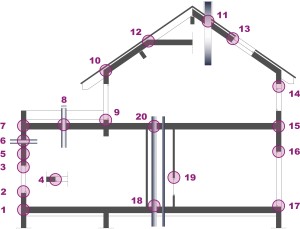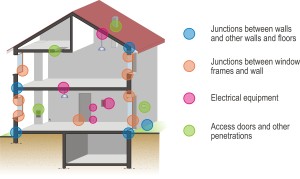Air penetrates through porous building materials and through joints in the building structure, therefore, airtight construction techniques must focus on these aspects. Different construction materials exhibit different leakage characteristics. Irrespective of construction material, a modern building is normally of double skin construction in which the inner and outer leaves are separated by a layer of insulation. Air-tightness is dependent on good sealing of the inner leaf by means of an air barrier system. [1]
With air barrier systems in place, key air infiltration paths to address are the interfaces between building components, most importantly interfaces between windows and walls, and between walls and roof or floors. [2]
Common leakage sites are listed in Figure 1 below. Figure 2 gives the classification of these sites in 4 categories [3]:

Figure 1: Vertical section of a typical building with identification of potential leakage junctions (Source: CEREMA – Pôle QERA)
- Junction lower floor / vertical wall
- Junction window sill / vertical wall
- Junction window lintel / vertical wall
- Junction window reveal / vertical wall (horizontal view)
- Vertical wall (Cross section)
- Perforation vertical wall
- Junction top floor / vertical wall
- Penetration of top floor
- Junction French window / vertical wall
- Junction inclined roof / vertical wall
- Penetration inclined roof
- Junction inclined roof / roof ridge
- Junction inclined roof / window
- Junction rolling blind / vertical wall
- Junction intermediate floor / vertical wall
- Junction exterior door lintel / vertical wall
- Junction exterior door sill / sill
- Penetration lower floor / crawlspace or basement
- Junction service shaft / access door
- Junction internal wall / intermediate floor
[1] Liddament M., 1996. Guide to energy efficient ventilation. AIVC, 1996.
[2] Van Den Bossche N., et al. 2011. Airtightness of the window-wall interface in cavity brick walls. Energy and Buildings. DOI: 10.1016/j.enbuild.2011.10.022
[3] Carrié F.R., Jobert R., and Leprince V., “Contributed Report 14- Methods and techniques for airtight buildings” AIVC, 2012.
The text and images of this webpage is available for modification and reuse under the terms of the Creative Commons Attribution-Sharealike 3.0 Unported License and the GNU Free Documentation License (unversioned, with no invariant sections, front-cover texts, or back-cover texts).
Posted in: Building Airtightness

